Employee advocacy on social media has been a natural & necessary progression.
When employees talk about a company on social, it amplifies promotions, boosts social recruiting and builds overall brand trust.
Adopting an employee advocacy program for your brand humanizes your brand & gives you a massive bump in social media engagement and reach.
A well-structured & planned advocacy program helps to share resources & guidelines among your staff to amplify your brand's sales & revenue through social media.
If you are looking to embrace employee advocacy on social media for your brand, you've landed at the right place.
In this article, we have encased all the details, statistics & examples of top brands to give you a fair idea about employee advocacy programs; dig deep into the steps & leverage employee advocacy tools to weave a successful advocacy program for your brand.
You can scroll through the article or jump to a section of your choice.
- What Is Employee Advocacy?
- Employee Advocacy Stats 2021
- Step To Kick Start Employee Advocacy Program
- Importance Of Employee Advocacy Program
- Employee Advocacy Best Practices
- Types Of Employee Advocacy For Your Brand
- Top Companies With Active Employee Advocacy Programs
- Statusbrew Social Media Employee Advocacy Tools
Click here to download detailed infographic on steps to kickstart an employee advocacy program.
What Is Employee Advocacy?
Employee advocacy is a meaningful way to connect to your audience & to leverage your brand's social media presence.
Top agencies & brands are adopting employee advocacy initiatives to amplify their brand image & make the brand credible & strengthen their target customer.
Brands are strategically weaving the initiative to imply the prospects of their assets, i.e., enthusiasm, expertise & dedication of their staff in driving customers to their marketing conduit.
Let's try to understand its meaning:
Employee Advocacy On Social Media
Employee advocacy denotes staff or team members promoting a brand's products or services and work culture.
Employees act as the ambassadors of the brand, which transmits the organization's mission to the common public & effectively gain trust.
Employee advocacy for social media initiatives requires zeal, comprehension, and proficiency to create an optimistic online scenario about the brand.
It is because employees are the authentic representatives of the company & their message and the impression towards the brand creates a lasting impact on the target audience.
Let's dive into the idea how employees act as an ambassador for the brand:
-
Employees promote your brand by word of mouth, through online communities & social media forums. Their activities increase brands' online and offline presence.
-
The brand ambassadors become the first point references of the brand & they make a powerful commitment & impression for the smooth operation of the brand.
-
Your employees recommend your brand's product to their circle, friends, and family. They influence the purchasing decisions of potential customers.
-
They exclusively participate in brands' ambassadorship efforts & become brand mouthpieces to encourage others to participate in advocacy initiatives.
-
Employees who become consul of the brand actively take part in talent acquisition & develop the brand both externally & internally with their best effort & interest.
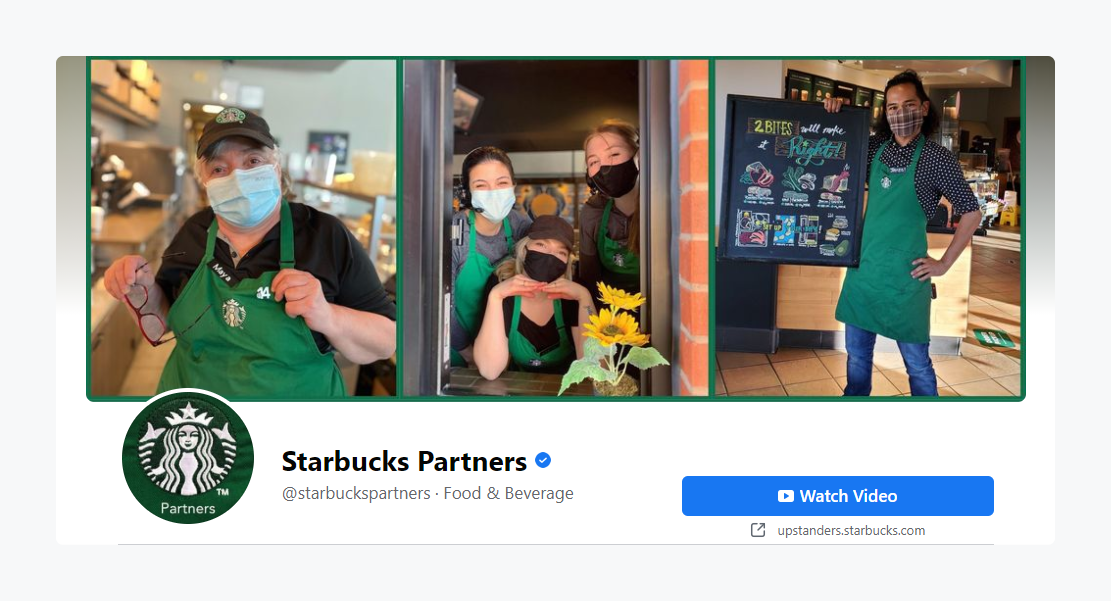
Image Source: Starbucks Partners Facebook
Suggested Read: Social Media Anxiety Post COVID-19 & How To Overcome It
Who Can Take Part In Employee Advocacy Program?
In a brand, some employees have more visibility by their position & responsibilities. However, managerial positions like CEO, Communication & Marketing Managers, Sales Manager, Human Resource Manager have a knitted circle.
Apart from the managerial positions, any employee of the organization who, by their efforts, can create a relevant market community and who gets attention & engagement on the content they can participate in the advocacy program.
As a brand, you should remember that successful implementation of the employee advocacy program relies on who is ready to be vocal about the brand on social platforms.
It is not linked to any specific position, but employees must have a regular presence & consistency in highlighting their expertise; they should have the rhythm to post content that represents the brand's positive image.
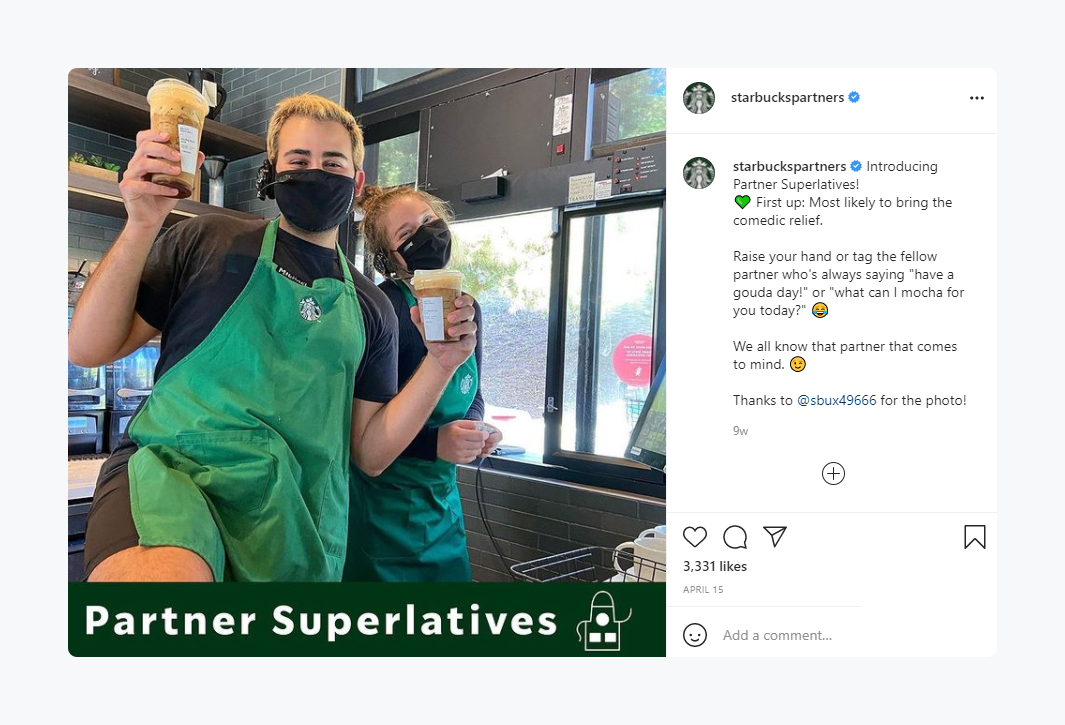
Image Source: Starbucks Partners Facebook
Employee Advocacy Stats 2021
If you're thinking about how effective employee advocacy can help you to achieve your goals, check out the stats:
-
84% of consumers rely on the recommendations of their closed circles, i.e., family or friends.
-
77% of users' purchase decisions depend on hearing from a person they trust.
-
Brands with a proactive team of an advocacy program display 21% greater profitability.
-
90% of B2B buyers engage with a person represented as a thought leader in their respective industry.
-
Absenteeism is reduced by 41% when companies have a proactive team.
-
The retention rate is 37% higher when an employee advocate is referring consumers.
Suggested Read: 100 Social Media Statistics You Must Know In 2021
Steps To Kick Start Employee Advocacy Program
How can you motivate your employees to be the advocates or brand ambassadors of the company?
What steps can advance a transparent employee advocacy initiative that can resonate with your brand's social media goals?
Strategic implementation of a plan & adopting a practical as well market-driven approach is a must for a successful launch of an employee advocacy program. Let's dive into a few vital steps, to begin with:
Step 1: Develop An Engaged Workplace
The first and foremost thing is to evolve a work culture where your employees can share & suggest their opinion. An open communication strategy among the teammates is essential to make your team proactive.
Besides good communication, streamline workflow among your employees & helps to achieve both internal and external goals. Furthermore, it helps in setting up goals & KPIs for advocacy programs.
Organize stand-ups to help your employees share their work, ask them to prepare weekly & monthly reports, keep the window open to hear about the problems they are facing.
Statusbrew Slack Integration enables your team's workplace communication easy. Slack is a messaging platform for businesses for quick real-time internal communication. Open and transparent communication helps employees to come up with ideas & apprehensions.
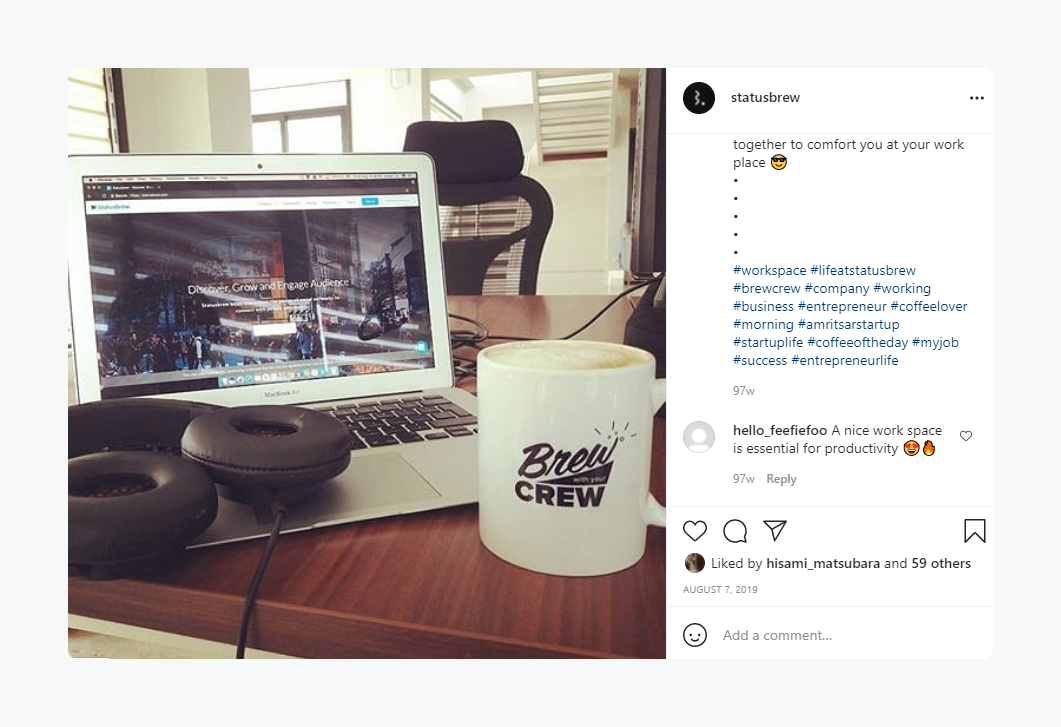
Image Source: Statusbrew Instagram
Suggested Read: Statusbrew Slack Integration: Slack For Brand Advocacy
Step 2: Set Your Goals & KPIs For The Program
Before starting employee advocacy initiatives, set goals and objectives. A defined goal & objective helps your employees quickly grasping the idea.
While deciding your goals, make sure to align them with your core business goals. Determine the KPI you want to measure for the program.
Metrics can give you clarity about the initiative; also, it helps you understand if any further improvement is required. Here the importance of employee advocacy tools such as Statusbrew arises.
Basic KPIs you should monitor:
-
Check out the top contributors in the program, which of your team member is driving more engagement or who is more enthusiastic & active on social media.
-
Monitor your organic reach & engagement.
-
Observe how people perceive your brand & content shared by your advocates is visible to how many people. Also, measure the engagement rate, clicks on links, comments re-sharing your content.
-
Get the data about website traffic your teammembers are driving to your brand site. Analyze how your employee advocacy programs are impacting brand sentiment in the market.
Statusbrew can be your one-stop solution to measure all the essential KPIs of your employee advocacy program.
Step 3: Team Onboarding
Make sure to select the employee advocates you want to involve in the program.
Ensure that your advocates are receptive to concerns & questions & they are open to new learnings.
Onboard employees who are already in a leadership position. To drive the best result, you can opt for a top-down approach.
You can cite examples of the employees who are already advocating your brand on different social media platforms. Apart from top brand leaders, engage team members who are natural in using social media & and who are passionate about your brand.
Assemble a team from different departments of your brand. Onboard individuals in your brand who are socially savvy, creative content creators, marketing specialists, designers to lead in directing content curation.
Suggested Read: Social Media Collaboration: Set Up Your Team For Success
Step 4: Discuss Rewards & Incentives
Explain the benefits of the advocacy program to your team. Help them understand how it can turn them into a thought leader of the industry & it will help them to build their credibility in the industry. Share concrete rewards like bonuses or awards or company swag. Give recognition to their effort.
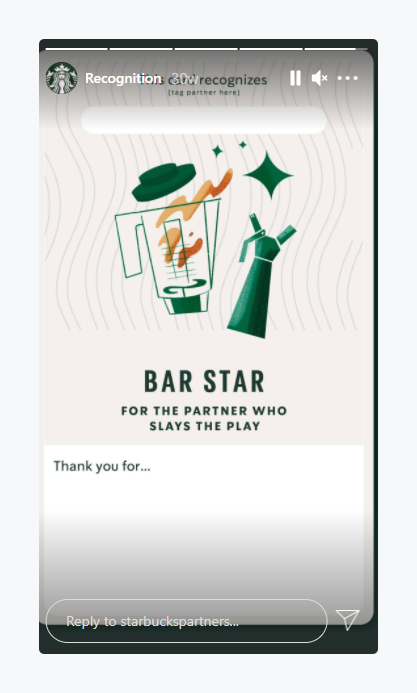
Image Source: Starbucks Partners Instagram
To reward your advocate's effort, put gamification in your strategy. For example, you can create a hashtag about your employee's campaign and share a leaderboard to check who is getting more engagement on social.
As an employer, make sure you are motivating your workforce to participate in the program willingly; your responsibility is to create enthusiasm.
Suggested Read: 300+ Best Hashtags For Instagram In 2021
Step 5: Share Resources & Train Your Employees
Empower your workforce to take part in the employee advocacy program. Involve them in designing and planning the campaign objectives. Share & make available the required resources for them, share tools whenever needed.
Create content like videos, infographics, update your workforce about new products. Encourage them to maintain consistency in content sharing & give them constructive feedback about their work.
You need to train & help your employee to understand the use of different software & tools.
Step 6: Create Social Media Guidelines
Before launching an employee advocacy program, prepare social media policy & guidelines to adhere to during the campaign.
It helps maintain the brand's cohesiveness, maintain its reputation, and keep the brand away from any legal issues.
Set up guidelines like how many posts advocates have to publish, what should be language, how should they reciprocate to comments, etc. Make sure that guidelines are easy to understand.
Suggested Read: The Best Times To Post On Social Media In 2021
Step 7: Encourage Your Team To Continue With The Program
To achieve your objectives & goals of employee advocacy programs, it is vital to maintain the program. Usually, during launch time, the excitement is high, and gradually it is reduced.
Send an email to your advocates reminding them about the importance of the program & why they are an integral part of success, discuss their work, organize weekly retrospective meetings.
It's vital to motivate & monitor your employees to work regularly to make your brands' employee advocacy program successful.
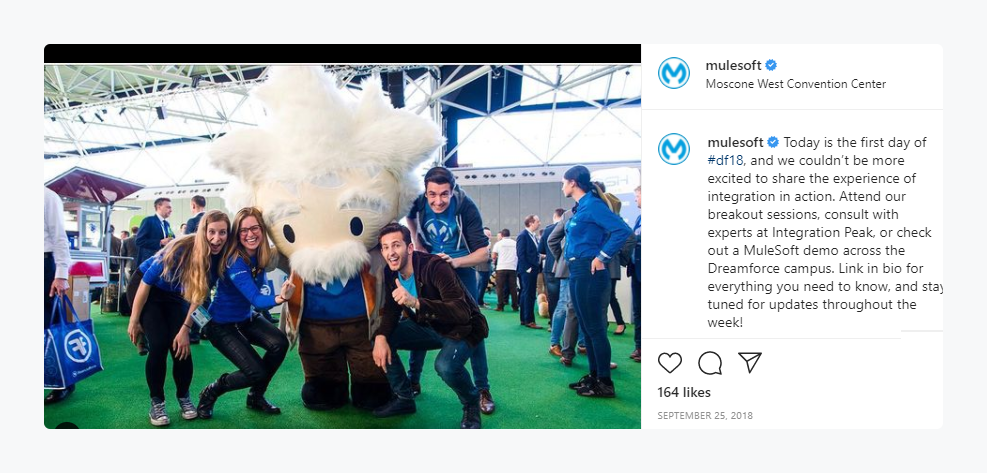
Image Source: MuleSoft Instagram
Importance Of Employee Advocacy Program
You should plan an employee advocacy program with implanted goals. Over the past years, brands have been well aware of how their employees can be the biggest asset on social media to make the brand identity.
Let's take a look at why companies with employee advocacy programs are emphasizing the importance of employee advocacy in their organizations.
-
Enhance Social Media Reach Cost-Effectively
Engaging employees in brand advocacy programs amplify the social media reach of the organization.
Collectively your employees can have a higher social reach than the organization and implementing employee advocacy programs acutely elongates your content reach.
As aforementioned stats have shown that when employees share content, your prospects perceive the facts & information more authentic, and tend to get more engaged.
It boosts brand awareness, enhances followers of your brand's social media profiles & converts prospects into customers by putting them into your marketing funnel.
Brands usually put money on advertising & to boost their content. But with employee advocacy, you can get organic reach & the process is cost-effective.
If your brand's content is not getting the desired reach, you should go for an employee advocacy program to fill the void. According to research, the leads generated through employee advocacy on social media have seven times more chances to convert into sales.
-
Increased Brand Visibility
Your potential customers & target audience innately trust the information & data shared by their peers.
For example, in an advocacy program, employees share content such as information about work culture, companies internal communication & activity & life inside the organization, content related to external communication like public events, shows, companies achievement, etc.
Employees' personalization of content gets connections and establishes relationships with the customers. People see an authentic human being as connected through content rather than a brand.
The audience values content & it gets the attention of your potential customers. It enhances the brand visibility among the crowd.
People in your employee's network start to search for your brand; they explore your brand. When your employees share content, they attach a human sentiment to the content.
-
Boost Product Sales
With the increasing use of social media, potential buyers search for more information on social & they rely on knowledgeable advisors who can help them.
In an employee advocacy program, your staff can be the trusted advisor well equipped with knowledge for products & services the company offers.
Their social media activity & sharing content about the company's product makes them a reliable source of information, and it makes it easy for the buyers to connect with them.
Employee advocacy programs in collaboration with your sales team boost the number of leads and help business growth. In addition, as the sales cycle is shortened, it also augments revenue generation.
-
Creates Positive Work Culture
One of the significant aspects of employee advocacy programs is that it enhances brand & employee interactions through advocacy program; crafts affinity and help in developing a connection with the brand. In addition, it elevates a positive work culture.
Employee advocacy programs by brands play a crucial role in 'relationship economics.' When your employees are socially active, they become optimistic, connected & inspired.
A proactive work environment where employee engagement is high has a positive impact on sales, profitability, productivity, absenteeism & staff turnover.
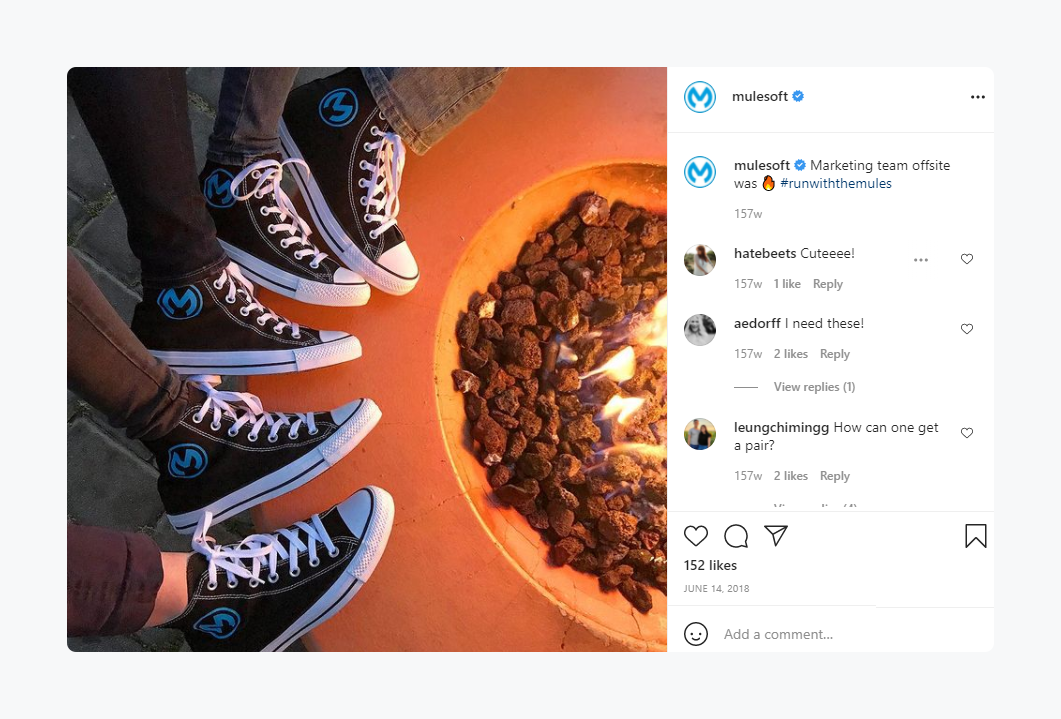
Image Source:MuleSoft Instagram
-
Develop Thought Leaders & Attract Talent
Advocacy programs help your brand employees with industry relevant content, and content that contemplates the brand they are working. Through employee advocacy programs, employees can learn about the brand's cohesive style, and they can also voice their opinion by being engaged in the content creation process.
The process makes your staff proficient, up to date, and source of information in the public forums. They become the powerhouse of knowledge & establish themselves as a thought leader in the industry.
They become a brand themselves; a thought leader becomes trustworthy to understand the company or organizations, and your prospect relies more on them than random marketing materials.
- A prominent & passionate thought leader of your brand also can attract top talents in the industry.
- The brand's reputation impresses the talents & they also want to be associated with the organization, team & thought leaders.
- Employees advocacy program makes your brand visible among the top talents & specialists who are looking for career growth.
Employee Advocacy Best Practices
To make advocacy programs time-efficient and maintain the coherence of content sharing, consider the following employee advocacy best practices.
These practices help to facilitate a concrete and practical employee advocacy initiative.
-
Guide your employees from time to time about the good practices of a brand ambassador. Prepare sprint & and retrospective meetings to set clear goals & to measure their performance.
-
Give them access to the approved content. Maintain a content review hierarchical process.
-
Ensure that your employee brand ambassadors have an in-depth understanding of the organization's work, products & services.
-
Discuss with your teammates to give motivation. Maintaining brand image & identity should be their priority.
-
Give them access to data to enhance their social media activity. Email them newsletters or any source of information, secondary data, stats, making them updated with the company's direction.
-
Involve them in the content creation process & ask for their suggestion and opinion. It enhances their sense of belonging to the brand. And also share rewards when they achieve goals.
-
Make sure that they are equipped with tools to share content with one click.
Suggested Read: 150 Social Media Acronyms & Slangs You Should Know
Types Of Employee Advocacy For Your Brand
When your employee shares a company's message through their activities, it helps the organization reach out to a new set audience and helps to build trust and a sense of authenticity towards the brand.
Are you wondering how to create a work environment that can foster employees advocating for your brand?
Check out the following types of employee advocacy ideas to get you started:
1. Employees: The New Social Media Influencers
Nowadays more & more people are vocal about their workplace, professional achievements, and recognition. People are quick about sharing positive & negative traits of work culture.
Employees usually share their jobs on social media. When they share positive news about the brand or the corporation on social media, it reaches many people & gets more engagement compared to the posts on the brands' social media profile.
To utilize their impactful social media presence, you can strategically plan content. For example, create blog posts, videos, carousel posts, behind-the-scenes images, office space captures, infographics and ask them to share their individual social media profiles.
When you give them access to well-planned content, you can engage socially less active companies of your brand in your advocacy program. Besides, it ensures that shared contents are according to brand standards & maintaining the coherence of the brand.
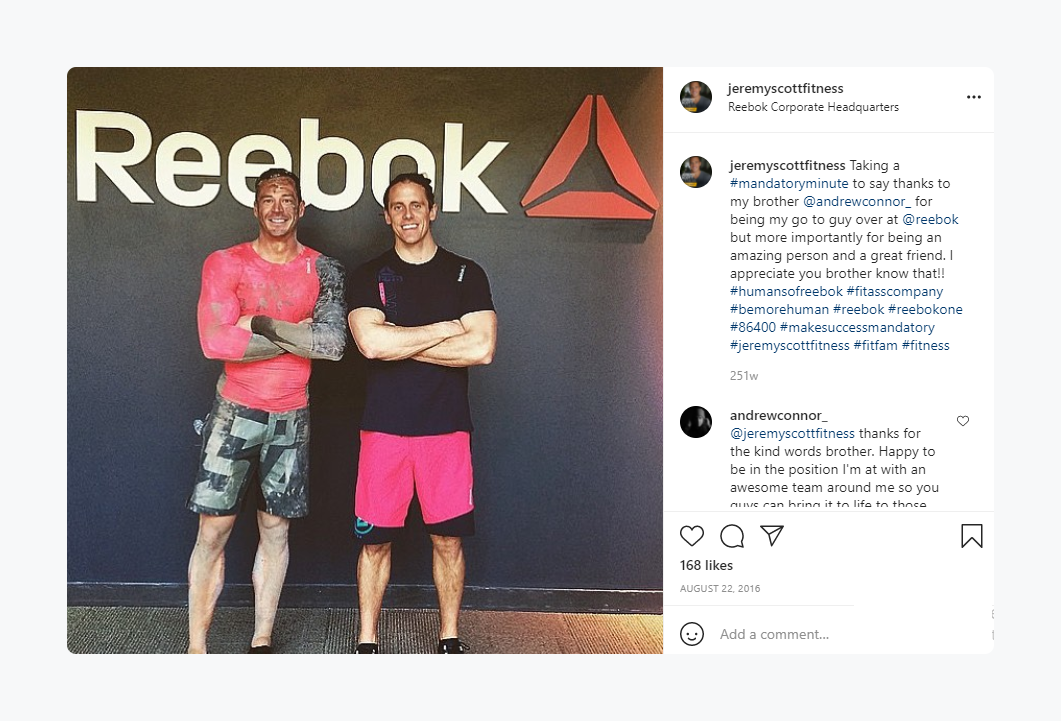
Image Source: Jeremy Scott Fitness Instagram
2. Thought Leaders
Another type of employee advocacy is to implement your employees as thought leaders. Encourage your employees to engage in the content creation process.
They can give you the idea of customers' needs & requirements, or help to participate in brainstorming sessions or motivate them to take pictures of team-building exercises or work culture.
When you involve your employees in the planning & research process, you foster a collaborative and creative environment.
Create a platform for your employees to show off their work on social media and your company simultaneously.
This type of employee advocacy helps your employees feel proud about their work, and they show pride on social channels about their work which helps to establish an image of your brand.
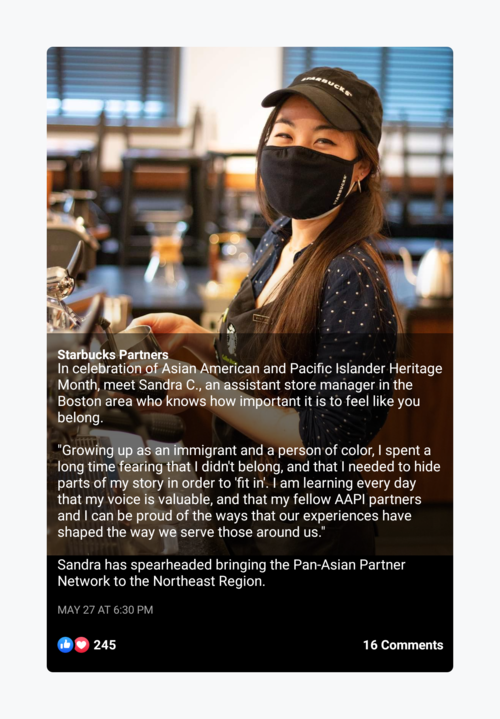
Image Source: Starbucks Partners Facebook
Suggested Read: 30 Social Media Experts To Follow On Instagram In 2021
3. Social Reviews
Another way of employee advocacy is to motivate your employees to share on social media about their work, brand work culture or communication process, positive work atmosphere & what they love about their job.
Encourage them to share reviews on sites like Glassdoor, Yelp, Google reviews, LinkdIn or Facebook. Social media users go through reviews before making their steps towards a brand.
Positive reviews on different social media channels make your brand reliable, and potential clients efficiently process your marketing funnel resulting in revenue growth. Consumers trust personal recommendations.
Also, ask them to comment on organizations' social media profiles. Commenting on reels, stories enhances engagement, and it helps to increase content reach, helping you to create brand visibility to your potential clients.
Suggested Read: How To Manage Google Reviews For Multiple Locations
4. Company SWAG
Give your employees t-shirts, pens or coffee mugs, stickers, or other usable office accessories with company logos.
They can flaunt the items on social media without much effort. Besides, whenever an employer wears the t-shirt with the company logo or uses the mug or the key chain, they create brand visibility by advocating on behalf of the brand.
Company swag is an old marketing tactic, but it creates a lasting impression and impacts your brand marketing effort.

Image Source: Statusbrew Instagram
Top Companies With Active Employee Advocacy Programs
Here are a few companies with employee advocacy programs who have aced in implementing & running the initiative:
Starbucks
Starbucks has a centralized employee advocacy program. The corporation has used the term 'Starbucks Partners' for their employee advocacy program; under this name, they have a Facebook, Instagram & Twitter page with a remarkable number of followers.
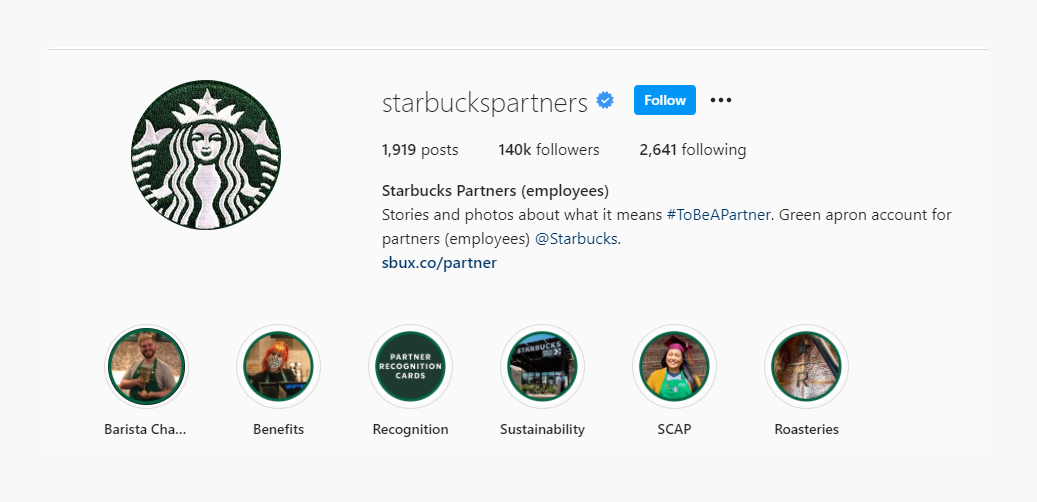
Image Source: Starbucks Partners Instagram
Creating a specific term for the workforce creates a sense of belonging among the crew, and simultaneously it is making the advocate accountable for their social actions. The brand also has detailed guidelines for the employee advocates that should be adhered to during their social media captivity.
The corporation's guidelines say the employees are the brand's partners because more than a job, it's their passion. So, the brand motivates the staff to go ahead and share it! The workforce shares their daily work, behind-the-scenes, and work culture on all' Starbucks Partners' social media profiles.
Dell
Dell has a top-notch, structured, and innovative employee advocacy program. From the inception of the initiative, the cooperating executive is imparting support towards it, and it is helping to drive success to the program.
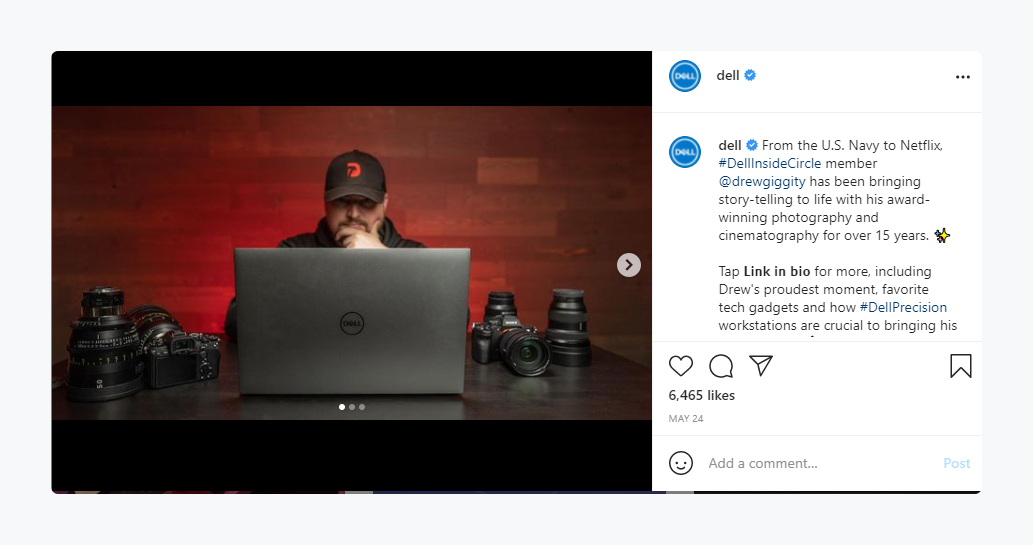
The corporation motivates its workforce to share content in a creative manner. Employee advocates of the brand share work culture, resources & why they love their job. On social media, employees are sharing their professional narratives with the hashtag #dellinsidecircle.
Dell's employee advocacy program is a massive success, since the program rolled out.
MuleSoft
MuleSoft is another inspiring example of employee advocacy. The initiative is helping the corporation in creating the brand identity & enhancing sales.
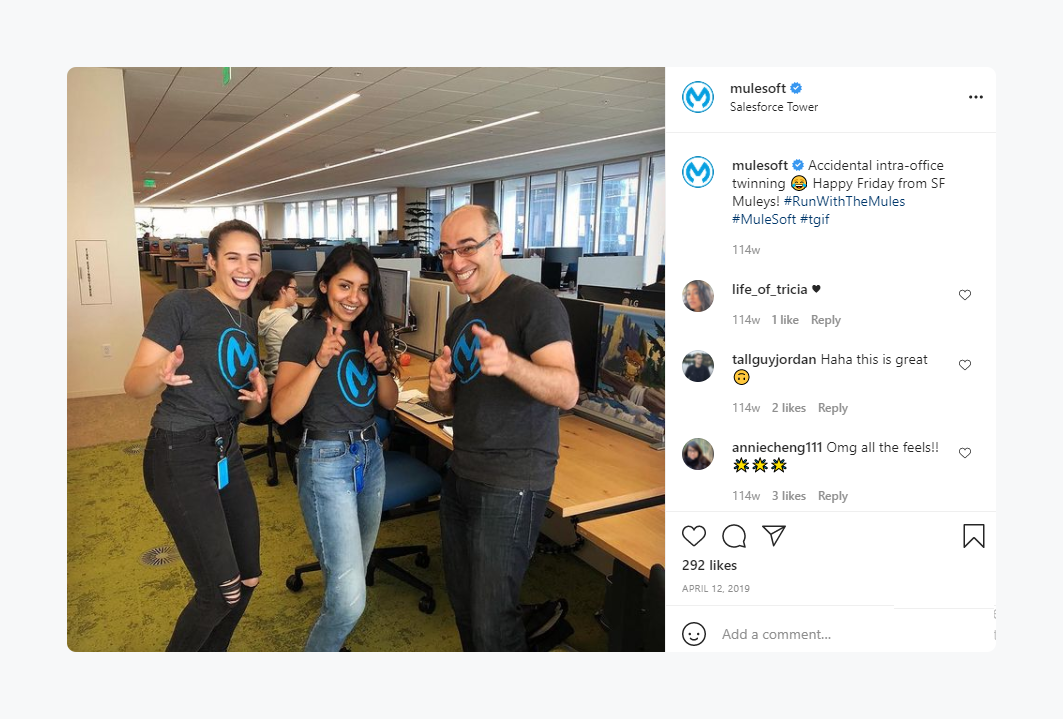
Image Source: MuleSoft Instagram
Employee advocates of the corporates share various articles, job ads among their peers' network, the activity of the advocates is making them credible and propel perceiving them as thought leaders.
Reebok
Reebok has trained the workforce about the process of being an advocate for the brand. Also, the brand is informing clearly about their roles & responsibilities.
Brand motivates the workforce to share their photos on social wearing Reebok products using the unique hashtags like #fitasscompany.
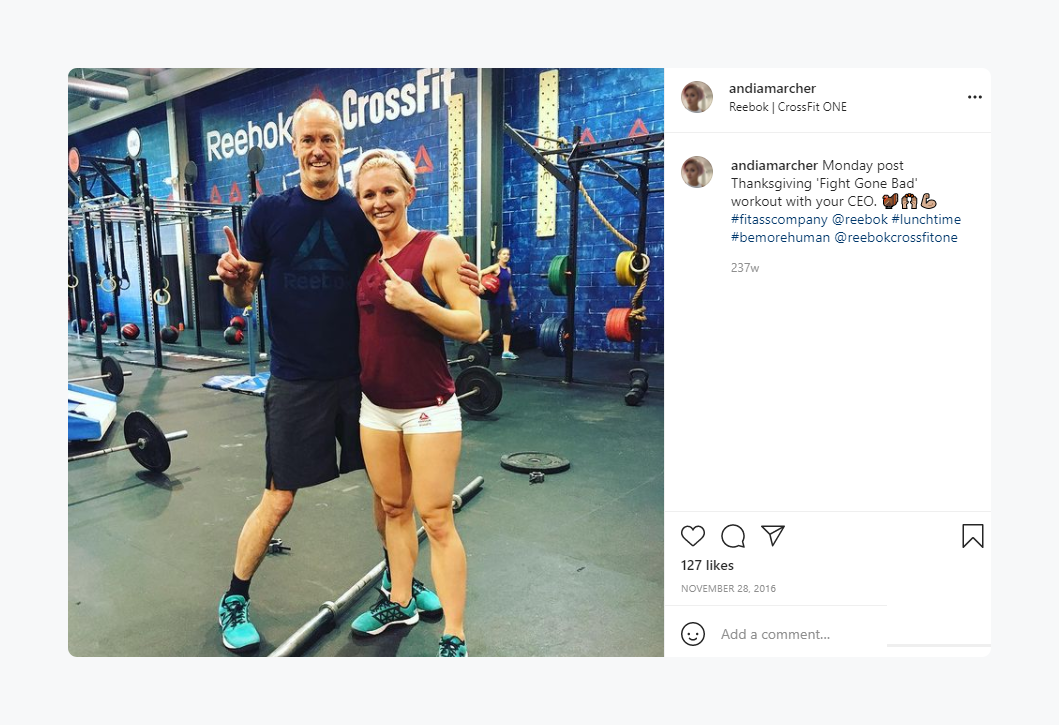
Image Source: Andi Archer Instagram
The brand initiative is focusing on specific targets like running, cycling, weightlifting, etc. The company keeps track of employee content with the hashtag & it is an great example of how to get your employees organized. In addition, the brand makes sure that the team is passionate about sport & they are avid social media users.
Statusbrew Social Media Employee Advocacy Tools
Statusbrew social media employee advocacy tools help brands to amplify brand reach & demonstrate thought leadership.
Statusbrew's Slack Integration helps Brands and Agencies to streamline team collaboration & helps the workforce to communicate quickly in real-time.
It makes it easier for your brand to share internal messages like news and company updates, within the same ecosystem.
Team members can get real-time notifications about publishing & engagement activities.
Statusbrew's report lets you measure different metrics that are necessary for the success of your advocacy program.
Book a free demo with Statusbrew or start your free trial.
Statusbrew is a unified tool that supports Facebook, Instagram, Twitter, YouTube, Linkedin, and even Google My Business.!
Infographic

Citation Policy: Please feel free to use these infographics in any commercial or non-commercial capacity. If you use the infographics, we require a reference back to Statusbrew Blog.

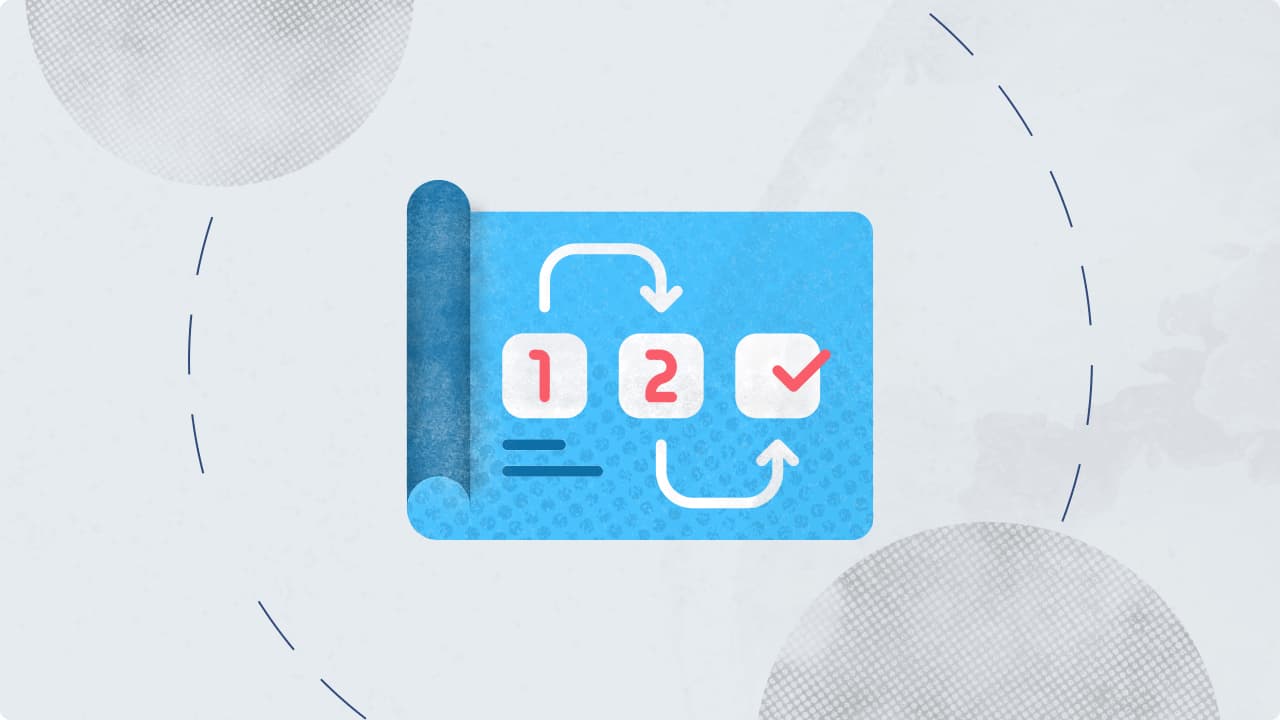


Explore the Statusbrew range of social media tools
Cancel anytime!